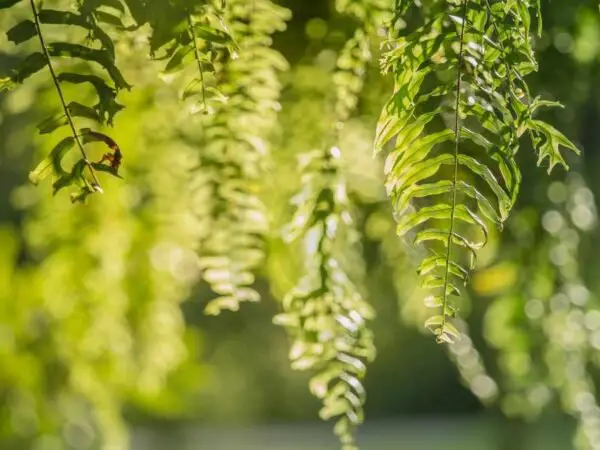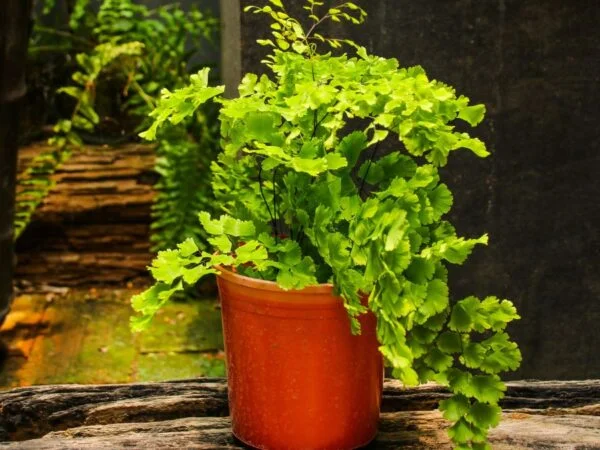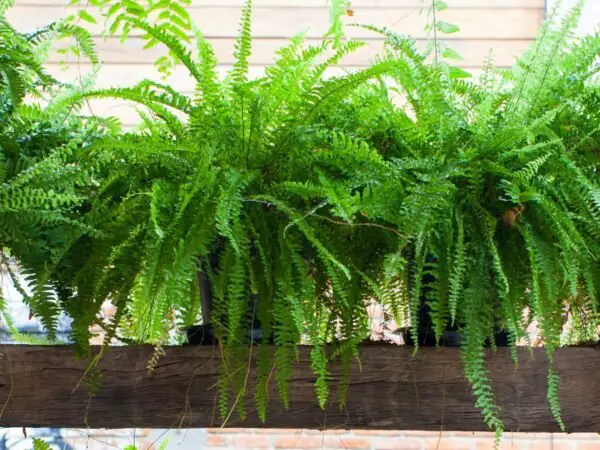Want to know how to attach a Staghorn Fern to a tree? You're in the right place! I'll guide you through the process step by step, making it easy and enjoyable.
To attach a Staghorn Fern to a tree, start by selecting a healthy fern and a sturdy tree branch. Next, wrap the fern's root ball in sphagnum moss and secure it with fishing line or wire. Then, position the fern against the tree trunk and attach it securely using nails, screws, or straps. Ensure the fern is in a shaded area with indirect sunlight and water it regularly to keep the moss moist. With proper care, your Staghorn Fern will thrive in its new tree habitat, adding a touch of natural beauty to your surroundings.
Ready to take your gardening skills to the next level? Explore different methods for mounting Staghorn Ferns, such as using wooden plaques or baskets, to find the perfect fit for your garden or home decor. Additionally, learn about the ideal growing conditions and maintenance tips to ensure your ferns stay healthy and vibrant year-round.
Key Takeaways
- Understand the unique needs of staghorn ferns when attaching them to trees.
- Gather the necessary tools and supplies before starting the attachment process.
- Prepare the tree bark properly to provide a suitable base for the staghorn fern.
- Securely insert the hook for hanging the staghorn fern in place.
- Use eye-hooks and wire to firmly attach the staghorn fern to the tree bark.
- Implement aftercare tips to ensure the health and growth of the staghorn fern.
Understanding Staghorn Ferns
Growth Habit
Staghorn ferns, known for their unique growth pattern, have two types of fronds: sterile and fertile. The sterile fronds are flat and shield-like, while the fertile fronds are antler-shaped for reproduction. These ferns attach themselves to trees using specialized structures called rhizomes, which act as anchors. In their natural habitat of tropical rainforests, staghorn ferns thrive in the moist, humid environment provided by tree trunks.

Ideal Conditions
To ensure optimal growth, staghorn ferns require high humidity levels similar to their native habitats. Adequate light is crucial but direct sunlight can scorch their fronds. Proper air circulation is essential to prevent fungal diseases and maintain overall health. When mounting on trees, ensure they receive indirect light and a humid microclimate for sustained growth.
Benefits of Tree Mounting
Mounting staghorn ferns on trees not only adds a decorative element to your garden but also replicates their natural habitat. This method allows the ferns to receive better air circulation and access to more light, leading to healthier growth. Tree mounting can be a space-saving solution for those with limited garden space.
Necessary Tools and Supplies
Selection Guide
When choosing a healthy Staghorn Fern, look for vibrant green fronds and avoid any signs of yellowing. Ensure the plant has a sturdy root system and no visible pests. Inspect the fern for any brown spots or wilting leaves, which may indicate underlying issues.
Preparing Supplies
- Essential tools: fishing line, sphagnum moss, wire mesh, and a tree branch.
- Role of supplies: fishing line secures the fern, sphagnum moss retains moisture, wire mesh provides stability.
- Efficiently prepare by soaking the sphagnum moss in water to make it pliable before use.
Safety Tips
- Handle tools with care to prevent injuries during attachment.
- Wear gloves and eye protection to safeguard against cuts and debris.
- To avoid accidents, ensure the ladder is stable before climbing to attach the Staghorn Fern.
Preparing the Tree Bark
Choosing the Right Tree
When selecting a tree for mounting Staghorn Ferns, consider trees with sturdy bark to support the fern's weight. Look for trees with rough bark that provide natural crevices for attachment. Ensure the tree is healthy and thriving to promote successful growth of the fern.
To attach a Staghorn Fern securely, opt for trees like oak, maple, or palm trees that have suitable bark textures. The size of the tree matters as well; choose a tree with a circumference large enough to accommodate the fern. Avoid trees with smooth or thin bark, as they may not offer enough surface area for attachment.
Identifying a tree that complements Staghorn Ferns involves examining factors such as bark texture, thickness, and overall health. Trees with deep ridges and crevices provide ideal spots for securing the fern. Ensure the tree is free from any diseases or pests that could harm both the tree and the fern.
Cleaning the Bark
Before attaching a Staghorn Fern, it's crucial to clean the tree bark thoroughly to ensure a strong bond between the fern and the tree. Use a soft brush or cloth to remove any debris, moss, or dirt from the bark surface. A clean bark surface promotes better adhesion of the fern.
Cleaning the bark not only enhances the aesthetic appeal of the attachment but also prevents mold or fungal growth that could harm both the tree and the fern. By wiping down the bark gently, you create an optimal environment for securing the Staghorn Fern in place.
A clean bark surface provides a stable foundation for attaching Staghorn Ferns, reducing the risk of detachment over time. It allows for better contact between the fern's root ball and the tree bark, facilitating nutrient absorption and overall growth.
Assessing the Health
To ensure successful attachment of Staghorn Ferns, assess both the health of the tree and the condition of your plant. Look for signs of disease or decay on both entities before proceeding with attachment. Healthy plants and trees promote longevity in their partnership.
Indicators of a healthy tree include strong foliage, robust branches, and no visible signs of damage or infestation. For Staghorn Ferns, vibrant green leaves, firm fronds, and well-established roots signify good health essential for attachment success.
Attaching a Staghorn Fern to an unhealthy tree can lead to detrimental consequences such as poor growth, nutrient deficiency, or even plant death. Ensure both your chosen tree and fern are in optimal health conditions before initiating attachment processes.
Inserting the Hook for Hanging
Hook Types
When attaching a Staghorn Fern to a tree, consider using various hook types. These include screw hooks, eye hooks, and swivel hooks. Screw hooks offer stability, while eye hooks provide flexibility in hanging positions. Lastly, swivel hooks allow for easy adjustment of the fern's orientation.
Selecting the most appropriate hook depends on factors like tree bark texture, fern size, and desired positioning. Screw hooks are ideal for trees with rough bark, ensuring a secure attachment. Eye hooks work well for smaller ferns or those requiring frequent repositioning. Swivel hooks are suitable for larger ferns needing occasional adjustments.
Installation Steps
To attach a Staghorn Fern to a tree successfully, follow these steps:
- Select a sturdy branch: Choose a healthy branch with enough space to accommodate the fern.
- Position the hook: Place the selected hook securely into the tree bark at a slight angle.
- Hang the fern: Lift the Staghorn Fern onto the hook carefully, ensuring it sits comfortably.
- Secure with wire or twine: Use wire or twine to fasten the fern to the hook gently but securely.
- Adjust as needed: Check the fern's position and adjust if necessary for optimal growth.
Inserting Eye-Hooks for Wiring
Eye-Hook Selection
Selecting the right eye-hooks is crucial for securely attaching the Staghorn Fern to a tree. Choose sturdy eye-hooks that can withstand the weight of the fern. Consider hooks with large openings for easy wiring.
When picking eye-hooks, opt for ones made of durable materials like stainless steel. Ensure the hooks are rust-resistant to maintain longevity. The correct eye-hook selection directly impacts the stability and durability of the attachment.
Drilling Guide
To create holes for the eye-hooks, use a drill or hammer with a suitable drill bit size. Position the holes strategically to ensure optimal support. When drilling into the tree bark, maintain precision to avoid damaging the tree.
For accurate drilling, mark the spots where you will insert the eye-hooks beforehand. Carefully drill into the bark at a slight upward angle to prevent water accumulation. Precision drilling is essential for securely anchoring the eye-hooks.
Secure Fixing
Securing the Staghorn Fern properly is vital to prevent it from dislodging over time. Use sturdy wires or ropes to fasten the fern tightly to the tree trunk. Employ techniques like creating a crisscross pattern with wires for added stability.
To ensure a stable attachment, periodically check and adjust the wiring as needed. Avoid overtightening, as this could damage both the fern and tree bark. Regular maintenance is key to preventing any loosening of the fern over time.
Wiring the Staghorn Fern to Bark
Wire Types
When attaching a Staghorn Fern to a tree, consider using coated wire, which is gentle on the fern's roots. Opt for flexible wire to allow for growth. For durability, galvanized wire is recommended due to its resistance to rust.
Selecting the right wire is crucial for a secure attachment. Coated wire prevents damage to the fern while ensuring flexibility. On the other hand, galvanized wire offers durability against environmental elements.
To ensure a successful attachment, choose galvanized wire for long-term stability. The coating of the wire should be soft enough not to harm the fern but sturdy enough to withstand outdoor conditions.
Wrapping Techniques
To securely attach the Staghorn Fern, start by wrapping the wire around its roots gently. Ensure that the wire is snug but not too tight to avoid damaging the plant. Continue wrapping until all roots are covered.
Begin by gently looping the wire around the fern's root ball, making sure it is secure but not constricting. Progress by wrapping the wire in a crisscross pattern, covering all exposed roots effectively.
Proper wrapping techniques are essential for maintaining stability. Avoid overtightening the wire, as this can impede growth and cause harm to the plant. Securely wrap all parts of the root ball for a balanced attachment.
Testing Stability
To test if your attached Staghorn Fern is stable, gently shake it to check for any wobbling or movement. A securely attached fern should remain firmly in place without swaying excessively.
A stable fern will show minimal movement when lightly shaken. If there is noticeable wobbling, adjust the wires accordingly by tightening them slightly. This ensures a secure attachment for optimal growth.
Inspecting stability is crucial for long-term health. Make adjustments as needed by reinforcing weak points with additional wraps or securing any loose sections with extra wiring.
Aftercare Tips
Watering Needs
Staghorn Ferns attached to trees require regular watering to thrive. Maintain optimal moisture levels by watering when the top layer of soil feels dry. Adjust frequency based on the weather; more water in hot seasons and less during colder months.
To ensure the health of your fern, avoid overwatering as it can lead to root rot. Monitor the plant closely and adjust watering accordingly for best results.
Sunlight Exposure
Staghorn Ferns on tree mounts prefer bright, indirect light for healthy growth. Place them where they receive dappled sunlight or morning sun with afternoon shade. Adjust exposure if you notice browning or yellowing leaves.
Too much direct sunlight can scorch the fern's leaves, while insufficient light may result in poor growth. Observe the plant's response to sunlight and make necessary adjustments.
Seasonal Adjustments
Adapting care routines for Staghorn Ferns during different seasons is crucial. In warmer months, increase watering frequency to account for higher evaporation rates. During winter, reduce watering as the plant's growth slows down.
Seasonal changes impact the fern's growth patterns and water requirements. Be attentive to these variations and adjust care practices accordingly.
Troubleshooting Common Issues
Pest Problems
Pests like aphids and mealybugs are common culprits that can harm Staghorn Ferns on tree mounts. These pests feed on the plant's sap, weakening its health. To prevent infestations, regularly inspect the fern for any signs of pests such as webs or sticky residue. Neem oil or insecticidal soap can help manage these pests effectively. If left unchecked, pests can lead to wilting fronds and hinder the fern's attachment to the tree.
Attachment Failures
Improper attachment techniques or inadequate support structures often result in attachment failures for Staghorn Ferns. Ensure that the fern is securely fastened using natural twine or wire, avoiding materials that may constrict growth. If facing attachment issues, gently remove the fern, assess the root ball for damage, and reattach it with proper adjustments. By maintaining a stable and sturdy mounting system, you can prevent future attachment failures and promote healthy growth.
Growth Concerns
When attached to trees, Staghorn Ferns may face growth concerns due to limited nutrients or insufficient sunlight exposure. To address this, consider supplementing with a balanced fertilizer to support optimal growth. Regularly trim any brown or damaged fronds to encourage new growth and maintain the fern's overall health. Despite challenges, ensuring adequate watering and providing occasional misting can enhance the fern's well-being and promote lush foliage.
Additional Mounting Ideas
Alternative Mounting Options
Staghorn Ferns can also be mounted on wooden boards or hanging baskets, providing versatility in display options. For those seeking a non-traditional approach, cork bark and tree fern fiber panels offer unique textures for mounting. These alternatives cater to various preferences and living conditions.
- Pros: Wooden boards are sturdy and easy to hang, while hanging baskets allow for flexible placement. Cork bark provides a natural look, and tree fern fiber panels offer excellent moisture retention.
- Cons: Wooden boards may require more maintenance, hanging baskets could limit air circulation, cork bark tends to degrade over time, and tree fern fiber panels might be harder to find.
- Depending on personal style and the desired environment for the fern, each option has its own set of advantages and disadvantages.
Creative Display Tips
Enhance the visual appeal of Staghorn Ferns by arranging them in geometric patterns on a wall or creating a vertical garden with multiple mounts. Incorporate different sizes of ferns for contrast or mix them with other plants for a diverse display. Utilize macramé hangers or decorative hooks to add an artistic touch to the presentation.
- Implementing imaginative displays not only showcases the beauty of the fern but also elevates the overall ambiance of the space.
- By experimenting with various arrangements and incorporating elements like driftwood or moss, one can create captivating focal points in any indoor or outdoor setting.
Closing Thoughts
Now that you have mastered the art of attaching a staghorn fern to a tree, you are well on your way to creating a stunning botanical display in your own backyard. Remember, understanding the needs of these unique plants and following the proper steps will ensure a successful and visually appealing outcome. With the right tools, techniques, and aftercare, your staghorn fern will thrive in its new environment, adding a touch of natural beauty to your surroundings.
Take pride in your newfound mounting skills and continue exploring creative ways to incorporate staghorn ferns into your garden or living space. Share your achievements with fellow plant enthusiasts and inspire them to embark on their mounting journey. By spreading the joy of gardening and botanical artistry, you contribute to a greener and more vibrant world. Keep nurturing your green thumb and let nature's wonders flourish around you.
Frequently Asked Questions
How do I prepare the tree bark for attaching a staghorn fern?
To prepare the tree bark for attaching a staghorn fern, follow these steps:
- Clean the bark surface to remove debris.
- Soak the bark in water to hydrate it.
- Allow the bark to dry partially before mounting the fern.
Can I use regular wire to attach my staghorn fern?
It is recommended to use copper or coated wire specifically designed for plants. Regular wire may rust and harm your staghorn fern over time.
What are some aftercare tips for a newly attached staghorn fern?
After attaching your staghorn fern, ensure:
- Regular misting to keep it hydrated.
- Avoid direct sunlight exposure.
- Monitor for pests or diseases regularly.
How can I troubleshoot common issues with my mounted staghorn fern?
If your mounted staghorn fern shows signs of distress:
- Check for overwatering or underwatering.
- Inspect for pest infestations.
- Ensure proper air circulation around the plant.
Are there alternative ways to mount a staghorn fern besides using tree bark?
Yes, you can also mount a staghorn fern on:
- Wooden plaques or boards
- Wire baskets filled with sphagnum moss These alternatives offer different aesthetics and mounting options.
Image Source: Paid image from CANVA





